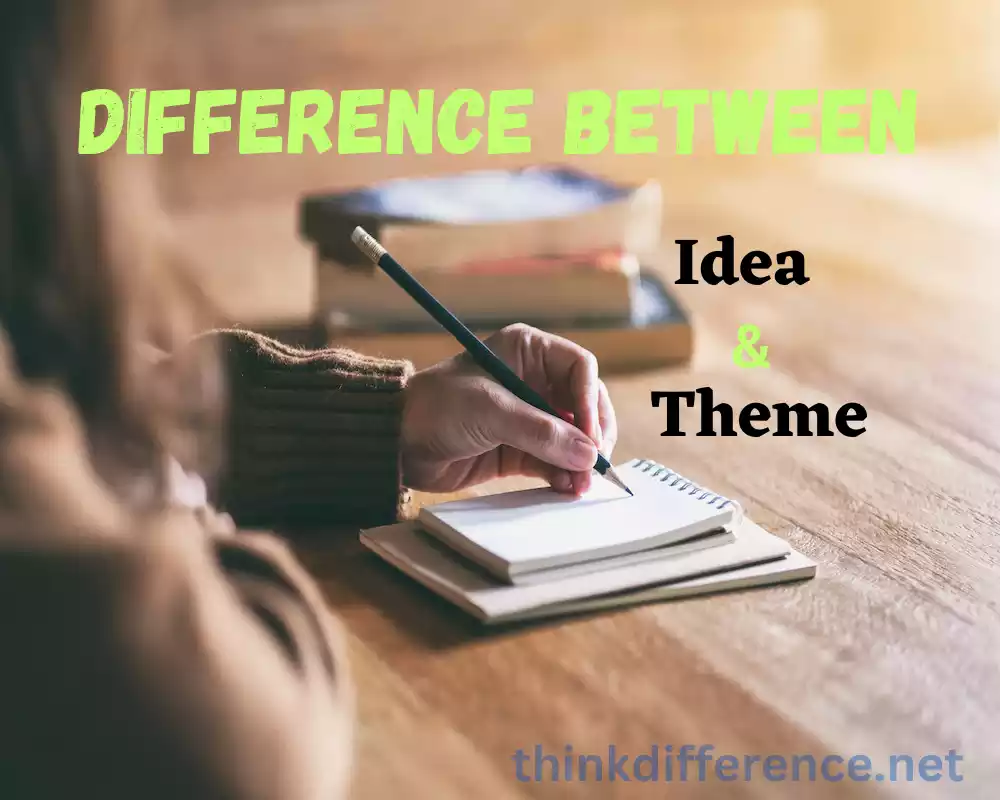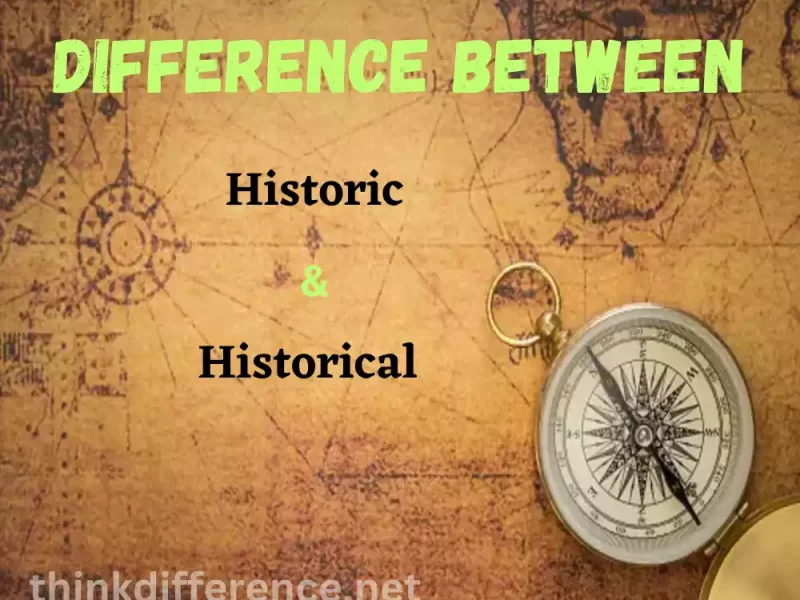Idea and Theme are integral in understanding various forms of media such as film, literature, art or even conversations in everyday life. Although closely linked, theme and idea each possess distinct properties which contribute differently towards creating creative work – by understanding these distinctions more fully we will gain greater insights into meanings, messages and intentions communicated by creators.
Concepts can be summarized into short phrases or sentences; each concept represents an idea which focuses on one aspect or feature of life or work, often providing greater depth and substance for an overall message. Ideas tend to be concrete and specific in form and serve as building blocks of larger concepts or works; helping develop further.
Themes are used to represent larger ideas which drive works and serve as their centerpiece. A theme encapsulates an abstract yet concrete idea which acts as the driving force of its narrative arc and central message or topic that’s explored and developed throughout. They tap into human nature’s basic characteristics while exploring significant issues or concepts from across time periods and disciplines – giving greater insights and comprehension for its subjects.
As part of our study of ideas and themes, we’ll investigate their definition, traits and roles within creative works. Additionally, we will also provide specific examples of themes/concepts being utilized across media forms; ultimately gaining a deeper insight into how themes/ideas contribute to artistic expression’s richness and depth.
Importance of understanding the difference Between Idea and Theme
Understanding the difference between ideas and themes is vitally important, for several reasons:
- Interpretation and Analysis: Differentiating between ideas and themes allows for a more accurate interpretation and analysis of creative works. It enables us to identify the specific concepts or thoughts being conveyed as ideas, while recognizing the overarching messages or central ideas as themes. This understanding enhances our ability to engage with the work on a deeper level and extract its intended meaning.
- Depth and Complexity: Ideas and themes work in tandem to create depth and complexity within creative works. Ideas provide the specific building blocks and details that contribute to the overall narrative, while themes provide the broader context and universal concepts that tie everything together. Recognizing this distinction enables us to appreciate the intricate layers and nuances present in the work.
- Artistic Intent: Artists, authors and creators often employ ideas and themes with specific intentions. Understanding the difference helps us recognize the deliberate choices made by the creator. By discerning the ideas and themes presented, we can gain insight into the artist’s perspective, explore their motivations and appreciate their creative vision.
- Communication and Expression: Ideas and themes are powerful means of communication and expression. They convey messages, emotions and viewpoints. By understanding the difference, we can better engage with the work and effectively communicate our own interpretations and reactions. It fosters meaningful discussions, encourages critical thinking and promotes a deeper appreciation of the artistic medium.
- Personal Growth and Reflection: Exploring ideas and themes within creative works often leads to personal growth and self-reflection. It allows us to connect with the work on a deeper level, relate it to our own experiences and gain insights into ourselves and the world around us. Understanding the distinction between ideas and themes facilitates this introspective process and enhances the potential impact of the work on our lives.
Comprehending the difference between idea and theme enriches our understanding, analysis and appreciation of creative works. It enables us to engage with the intentions of the creator, delve into the depth and complexity of the work and facilitate personal growth through self-reflection. By recognizing and exploring ideas and themes, we can fully embrace the transformative power of art and media.
What is an Idea?
An idea is any concept or notion expressed through words alone or short phrases or sentences. It represents an individual notion or understanding of something, often focusing on a particular aspect or subject. Ideas are typically concrete, specific and serve as the building blocks of larger concepts or works.

Ideas can be found everywhere from conversations among friends to artistic creations. They contribute to the development and expression of thoughts, perspectives and messages. Ideas can range in complexity depending on their context of implementation.
In creative works, ideas can manifest through characters, settings, plots, dialogue or symbolism. They provide the foundation upon which the work is built and help convey meaning, evoke emotions and engage the audience. Ideas can be used to explore various themes, as they offer specific concepts that contribute to the larger narrative or message.
Examples of ideas include love, friendship, courage, betrayal, freedom and justice. Each icon represents an abstract concept which can be explored further and understood differently by different audiences. Ideas can be expressed concisely and are often open to individual interpretation and personal experiences.
By examining and analyzing ideas within a work, we can gain a deeper understanding of its purpose, explore different perspectives and engage in meaningful discussions about the concepts presented. Ideas serve as the catalysts for creativity and provide the starting point for the exploration of broader themes and concepts.
What is Theme?
The theme refers to the main idea or message conveyed through film, literature or art works. Other creative forms of artistic expression. It represents a broader and more abstract concept that is explored and developed throughout the piece. Themes provide a lens through which the audience can interpret and analyze the work, offering a deeper understanding and insight into the subject matter.

Themes are universal in nature, addressing fundamental aspects of the human condition or exploring significant ideas or issues. They often transcend the specific characters, events or settings of a work and tap into larger concepts that resonate with a wide range of audiences. Themes can evoke emotions, provoke thought and offer commentary on various aspects of life, society or the human experience.
One of the greatest assets of themes is their capacity to bridge across time periods, cultures and artistic mediums. They can be found in ancient myths, classic literature, contemporary films and even in everyday conversations. Themes may range widely and cover topics like friendship, love and betrayal as well as redemption, justice power identity.
Themes in an artwork don’t need to be explicitly stated – rather they can be revealed through its story, characters’ dialogue and symbolism, as well as overall structure of work. Through the exploration of conflicts, character arcs and plot developments, themes gradually emerge, providing deeper layers of meaning and interpretation. Different works may have multiple themes and their complexity often invites diverse interpretations and discussions among audiences.
Themes serve to enrich and engage the audience, inviting reflection, empathy and a deeper understanding of the human condition. By exploring and analyzing themes, we can appreciate the profound impact and lasting resonance that creative works can have on our lives.
Exploring the Importance of Idea and Theme in Writing
Concept and subject matter in writing cannot be overemphasized – they play a pivotal role in how works are perceived by readers, as well as its overall efficacy. Here are several main reasons for their importance when writing:
- Provides a Clear Focus: The idea serves as the central concept or message that guides the entire writing process. It provides a clear focus and direction for the writer, ensuring that the content remains cohesive and purposeful. Having a well-defined idea helps writers stay on track and effectively communicate their intended message to the readers.
- Engages the Reader: Ideas and themes are the backbone of engaging writing. An engaging piece of writing explores concepts or themes in such a way that draws the readers in and prompts further investigation of its contents. By evoking curiosity, emotions or a sense of relevance, strong ideas and themes enhance the reader’s engagement, making the writing more impactful and memorable.
- Enhances Depth and Meaning: Ideas and themes add depth and meaning to writing. They allow writers to explore complex concepts, universal truths or thought-provoking questions. By delving into these deeper layers, writing becomes more thought-provoking, resonant and intellectually stimulating. Ideas and themes elevate writing from mere surface-level content to meaningful and insightful compositions.
- Provides Unity and Coherence: Ideas and themes provide a unifying thread that ties the various components of a piece of writing together. They create coherence and ensure that the content flows logically and purposefully. When ideas and themes are seamlessly integrated, it helps readers follow the writer’s train of thought and understand the intended message or narrative.
- Sparks Critical Thinking: Exploring ideas and themes in writing encourages critical thinking in both the writer and the reader. It prompts analysis, interpretation and reflection, fostering a deeper understanding of the subject matter. By engaging with complex ideas or examining different perspectives through themes, writing becomes a tool for intellectual growth and expanding one’s worldview.
- Establishes Emotional Connection: Effective writing elicits emotional responses from readers. Ideas and themes that resonate with readers’ experiences, emotions or values establish a powerful emotional connection. This connection can evoke empathy, inspire action or provoke self-reflection, making the writing impactful and memorable.
- Stimulates Discussion and Dialogue: Strong ideas and themes fuel discussion and dialogue among readers. When writing explores compelling ideas or presents thought-provoking themes, it sparks conversations, debates and exchanges of viewpoints. This not only enhances the reader’s engagement but also creates a community of readers who can collectively explore and appreciate the work.
Idea and theme are essential in writing as they provide focus, engage the reader, add depth and meaning, create unity and coherence, stimulate critical thinking, establish emotional connections and encourage discussion. By employing powerful concepts and ideas, authors are able to write compelling pieces that capture readers’ hearts while leaving lasting impressions in them.
Generating Ideas and Themes
Locating themes and ideas requires creativity, exploring different sources for inspiration as well as employing various techniques can help generate ideas.

Here are a few suggestions to assist with finding ideas and themes:
- Brainstorming: Set aside dedicated time for brainstorming sessions. Write down any ideas or concepts that come to mind, without judgment or evaluation. Allow your thoughts to flow freely and explore different angles or perspectives.
- Observing the World: Pay attention to your surroundings and observe the world with a curious and open mindset. Take inspiration from everyday situations, interactions and events. Reflect on the emotions, conflicts or themes that emerge from these observations.
- Reading and Research: Engage in extensive reading across different genres and subjects. Browse blogs, books, articles and magazines and make note of which themes, concepts or ideas appeal to you most – then consider ways these concepts might fit into your writing projects.
- Personal Experiences: Draw from your own life experiences, memories and emotions. Reflect on the challenges, triumphs or conflicts you’ve encountered. Explore themes related to identity, relationships, personal growth or resilience based on your unique perspective.
- Freewriting: Set a timer and write continuously without stopping or censoring yourself. Allow your thoughts to flow onto the page without worrying about structure or grammar. Freewriting can help you uncover hidden ideas and themes lurking in your subconscious.
- Asking “What If” Questions: Pose hypothetical questions starting with “What if.” Explore different scenarios and their potential outcomes. Consider how these scenarios can be developed into ideas or themes that explore human nature, societal issues or personal dilemmas.
- Seeking Inspiration from Art and Media: Engage with multiple forms of art such as film, literature music visual arts and theater. Analyze the ideas and themes presented in these works and consider how they can be adapted or expanded upon in your writing.
- Reflecting on Current Issues: Stay informed about current events, social issues and cultural phenomena. Reflect on the themes or underlying ideas that emerge from these contexts. Consider how you can address or explore these themes in your writing.
- Mind Mapping: Create a visual mind map by placing a central theme or idea in the center of a page and branching out with related concepts, associations or sub-themes. This technique helps to generate a network of interconnected ideas and themes.
- Collaborating and Discussing: Engage in conversations with other writers, artists or creative individuals. Share ideas, discuss concepts and seek feedback. Collaborative discussions often spark new ideas and expand your perspective.
Remember, generating ideas and themes is a dynamic and iterative process. Be open to experimentation, exploration and revision as you refine and develop your concepts. Engaging fully with the creative process and being open to receiving inspiration from various sources are keys to successful writing.
Developing Ideas and Themes in Writing
As part of any writing endeavor, developing themes and ideas requires careful and systematic approach. Here are a few suggestions that may help you develop and enhance your ideas and themes:
- Reflect on Your Initial Ideas: Review the ideas you generated and reflect on their potential. Consider the ones that resonate with you the most or have the most potential for exploration. Ask yourself why these ideas appeal to you and how they align with your writing goals.
- Clarify Your Message: Define the core message or takeaway you want to convey through your writing. What do you want your readers to understand, feel or learn? Clarifying your message helps you refine your ideas and shape them into a coherent theme.
- Conduct Research: Dive deeper into your chosen idea or theme through research. Read books, articles or studies related to your topic. Explore different perspectives, historical context or cultural references. Research provides an excellent opportunity to collect relevant data, gain new insight and expand on knowledge regarding an issue or subject matter.
- Identify Subthemes and Related Concepts: Break down your main theme into subthemes or related concepts. Explore different aspects, angles or dimensions of your theme. This approach to writing can add depth and nuance to your piece and allow you to explore various facets of a topic in detail.
- Create a Conceptual Framework: Develop a conceptual framework that outlines the key elements of your theme. Identify the major ideas, subthemes and supporting concepts that will be explored in your writing. This framework serves as a roadmap to guide your writing process.
- Use Symbolism and Metaphor: Consider incorporating symbolism and metaphor into your writing to enhance the exploration of your theme. Symbolic elements can deepen the meaning of your ideas, evoke emotions and engage readers on a symbolic level.
- Create Compelling Characters and Storylines: Develop characters and storylines that embody and interact with your theme. Show how your theme influences their actions, decisions and personal growth. Engaging narratives and relatable characters make your theme more tangible and impactful for readers.
- Show Different Perspectives: Present multiple perspectives or viewpoints related to your theme. This adds complexity and richness to your writing, allowing readers to consider different angles and interpretations. Exploring diverse perspectives encourages critical thinking and opens up discussions.
- Use Imagery and Descriptive Language: Utilize vivid imagery and descriptive language to evoke emotions and create a sensory experience for readers. Bring your theme to life through sensory details, powerful metaphors and engaging descriptions. This immerses readers in your writing and enhances their connection to your theme.
- Revise and Refine: Continuously revise and refine your writing as you develop your ideas and themes. Ensure that your ideas are effectively communicated, the theme is consistently explored and the writing is cohesive. Seek feedback from trusted readers or writing groups to gain insights and refine your work further.
Remember, developing ideas and themes is an ongoing process. Stay open to new insights, be willing to revise and allow your writing to evolve. By dedicating time and effort to develop your ideas and themes, you can create impactful and resonant pieces of writing.
Enhancing the Impact of Ideas and Themes
To enhance the impact of your ideas and themes in your writing, consider the following strategies:
- Emphasize Clarity: Ensure that your ideas and themes are communicated clearly to the reader. Use precise language and avoid ambiguity. Clearly state your main idea or theme early on and reinforce it throughout your writing.
- Show, Don’t Tell: Instead of explicitly stating your ideas or themes, demonstrate them through compelling storytelling and vivid descriptions. Use descriptive language, sensory details and engaging narratives to allow readers to experience and connect with your ideas on an emotional level.
- Develop Strong Characters: Create well-rounded, relatable characters that embody your themes. Show how your characters grapple with and evolve in relation to the ideas you’re exploring. Make their conflicts and choices reflect the deeper themes, adding depth and resonance to your writing.
- Utilize Symbolism and Metaphor: Incorporate symbolism and metaphor to deepen the meaning of your ideas. Symbolic elements can evoke emotions, create layers of interpretation and invite readers to engage with your themes on a deeper level. Use symbols and metaphors strategically to enhance the impact of your writing.
- Employ Contrast and Conflict: Explore contrasting ideas or conflicting perspectives within your themes. This adds complexity and tension, making your ideas more thought-provoking and engaging. Contrasting elements can create dynamic narratives and generate discussions among readers.
- Appeal to Emotions: Emotions have a powerful impact on readers. Infuse your writing with emotional depth by exploring the emotional aspects of your themes. Tap into universal emotions such as love, fear, joy or loss to connect with your readers and make your ideas resonate on an emotional level.
- Use Evocative Language: Choose words and phrases that evoke strong imagery and create a lasting impression. Engage readers’ senses through vivid descriptions and sensory details. This helps to immerse readers in your writing and enhances the impact of your ideas and themes.
- Provide Thought-Provoking Questions: Pose thought-provoking questions related to your ideas or themes. Encourage readers to reflect on their own experiences, beliefs or perspectives. Thought-provoking questions invite deeper engagement and personal introspection, enriching the impact of your writing.
- Incorporate Relevance and Universality: Ensure that your ideas and themes have relevance beyond the specific context of your writing. Connect your themes to broader human experiences, societal issues or universal truths. This allows readers to relate to and find personal meaning in your writing.
- Foster Reader Engagement: Encourage reader engagement by inviting them to actively participate in the exploration of your ideas and themes. Ask for their opinions, create space for discussion or leave room for interpretation. Engaged readers are more likely to internalize and be impacted by your ideas and themes.
Remember, the impact of your ideas and themes is not solely dependent on individual elements, but rather the cumulative effect of their interplay throughout your writing. Continuously refine and polish your writing to strengthen the impact of your ideas and themes and consider seeking feedback from trusted readers to gain insights and perspectives.
The Role of Idea and Theme in Different Writing Genres
Idea and Theme in Popular Writing Genres. The function of ideas and themes differs across writing genres due to individual rules and expectations for each form of writing, so let’s look at their importance within some popular genres:
- Fiction: In fiction, the idea or concept serves as the foundation for the story. It drives the plot and character development. Themes provide the underlying messages or insights that the author wants to convey. They explore universal concepts, social issues or human experiences. Fiction writers may create subtle or explicit themes depending on their intentions and the type of story told.
- Nonfiction: In nonfiction writing, the idea typically centers around a specific topic or subject matter. The writer’s purpose is to inform, educate or persuade readers about that idea. Themes in nonfiction often emerge through the exploration of the topic, revealing deeper insights, patterns or connections. Themes can provide a cohesive structure to the content and help the writer communicate their intended message effectively.
- Poetry: Ideas and themes play a significant role in poetry. Poets often use concise and evocative language to convey their ideas and explore profound themes. The idea in poetry could be a specific concept, emotion or experience, while the theme represents the overarching message or philosophy expressed through the poem. Poetry allows for rich and layered exploration of ideas and themes, often using metaphors, symbolism and vivid imagery.
- Drama: Ideas and themes in drama are central to the development of the play. The idea sets the premise or concept on which the dramatic work is based, providing the foundation for conflict and action. Themes in drama explore human nature, societal issues or philosophical questions, often through the interactions and conflicts of the characters. Drama uses dialogue, stage directions and dramatic devices to bring ideas and themes to life.
- Memoir: Memoirs are based on personal experiences, and the idea revolves around the specific events or moments that the author wishes to recount or reflect upon. Themes in memoirs often revolve around personal growth, self-discovery or the exploration of identity. The author may draw broader lessons or insights from their experiences, shaping the narrative around those themes.
- Journalism: In journalism, the idea is typically a newsworthy event or topic that the writer is reporting on. The primary goal is to provide objective information and present different perspectives. Themes in journalism can emerge through the analysis and synthesis of the facts, revealing larger patterns or issues. Themes help provide context and depth to the reporting, enabling readers to understand the significance of the idea being presented.
- Essay: Essays can cover a wide range of topics and styles. The idea in an essay represents the central argument, concept or question that the writer is exploring. Themes in essays can be specific to the topic or broader in scope, depending on the writer’s approach. Essays often delve into philosophical, social or cultural themes, using evidence and analysis to support the writer’s perspective.
While the role of idea and theme may differ across genres, they both contribute to the overall impact and meaning of the writing. They shape the content, guide the reader’s interpretation and provide a cohesive structure to the piece. Understanding the specific role of idea and theme in different genres helps writers effectively convey their intended messages and engage their target audience.
Evaluating the Effectiveness of Idea and Theme
Assessing the impact of an idea and thematic elements is an assessment process that depends on many different elements, including your intention, the intended audience and overall effectiveness. Here are a few aspects you should take into consideration when judging their effect in writing:
- Relevance: Assess how relevant the idea and theme are to the overall context of the writing. Do they align with the purpose of the piece? Are they meaningful and significant in relation to the subject matter? The idea and theme should resonate with the reader and contribute to the overall message or exploration of the work.
- Coherence and Consistency: Consider how well the idea and theme are developed and sustained throughout the writing. Are they consistently woven into the narrative or argument? Do they form a cohesive and logical framework for the content? The effectiveness of idea and theme is enhanced when they are seamlessly integrated into the writing and provide a clear direction or focus.
- Originality and Depth: Evaluate the originality and depth of the idea and theme. Are they thought-provoking, engaging or unique? Do they offer fresh insights or perspectives? An effective idea and theme capture the reader’s attention and offer a deeper understanding or exploration of the subject matter. They should go beyond surface-level observations or clichés.
- Emotional Impact: Consider the emotional impact of the idea and theme on the reader. Do they evoke emotions, resonate with personal experiences or create a connection? Effective ideas and themes can elicit strong emotional responses, whether it’s empathy, reflection, inspiration or contemplation. They should touch the reader on an intellectual and emotional level.
- Universality and Relevance to the Audience: Evaluate the universality and relevance of the idea and theme to the intended audience. Are they relatable and applicable to a wide range of readers? Effective ideas and themes have the potential to transcend specific contexts and resonate with diverse audiences. They address common human experiences, values or dilemmas.
- Impact on Reader’s Perspective: Assess the impact of the idea and theme on the reader’s perspective or worldview. Do they challenge assumptions, provoke critical thinking or encourage personal reflection? Effective ideas and themes have the power to broaden perspectives, stimulate dialogue or inspire change in the reader’s thinking or behavior.
- Alignment with Writing Goals: Consider how well the idea and theme align with the writer’s intended goals or objectives. Do they effectively communicate the writer’s intended message or purpose? Ideas and themes with wide appeal can contribute significantly to a writer’s overall writing success by effectively conveying their goals while leaving an impactful lasting impression on readers.
It’s important to note that evaluating the effectiveness of idea and theme is subjective and can vary depending on individual readers’ interpretations and preferences. What resonates with one reader may not resonate with another. It’s essential for writers to consider their target audience and seek feedback from trusted sources to gauge the effectiveness of their idea and theme.
Comparison table of Idea and Theme
Here is a table that compares major distinctions between Idea and Theme:
| Aspect | Idea | Theme |
|---|---|---|
| Definition | Specific concept or concept | Broad underlying concept or message |
| Nature | Concrete and specific | Abstract and general |
| Focus | Specific element or aspect of the work | Overarching concept explored in the work |
| Scope | Limited in scope | Broader in scope |
| Purpose | Drives the narrative or argument | Provides deeper meaning and insight |
| Exploration | Developed and expanded upon within the work | Explored and examined throughout the work |
| Expression | Tangible and observable | Abstract and inferred |
| Examples | Character motivation, plot point, setting detail | Love, justice, identity, freedom |
The Relationship between idea and theme
The relationship between idea and theme can be described as follows:
- Idea as the Foundation: The idea serves as the foundation or starting point for the exploration of a particular concept or concept within a piece of writing. It represents the specific concept or thought that the writer wants to convey or explore. The idea provides the initial direction and focus for the work.
- Theme as the Underlying Message: The theme emerges from the exploration and development of the idea. It represents the deeper, underlying message or insight that the writer wants to convey to the reader. The theme is the broader concept or concept that encompasses and connects multiple ideas within the work.
- Idea as the Building Blocks: Ideas form the building blocks of a work, encompassing specific elements such as characters, plot points, settings, conflicts or narrative devices. These ideas should form part of your overall plot and bring life to your story. They add detail, depth and specificity to the work.
- Theme as the Coherent Framework: Themes provide a coherent framework or lens through which the ideas are examined and interpreted. They offer a conceptual understanding of the work, allowing readers to grasp the deeper meaning and purpose behind the individual ideas. Themes provide cohesion and unity, tying the ideas together into a larger, meaningful whole.
- Idea as the Expression: Ideas are the specific expressions or manifestations of the larger theme. They represent the tangible aspects of the work that readers can engage with and analyze. Ideas play an integral part in character creation, development and the world building process of stories.
- Theme as the Interpretation: Themes guide the interpretation and analysis of the ideas within the work. They provide a lens through which readers can understand the significance and relevance of the individual ideas. Themes invite readers to consider the broader implications and universal concepts presented in the work.
The relationship between idea and theme can be seen as a hierarchical one, with the idea serving as the specific concept or concept and the theme representing the broader, underlying message or insight. Ideas contribute to the development of the work, while themes provide coherence and deeper meaning. The ideas express the theme, and the theme guides the interpretation of the ideas. Together, idea and theme work in tandem to create a compelling and meaningful piece of writing.
Summary
Ideas and Themes form the backbone of extraordinary writing. They are the invisible threads that weave together the tapestry of a captivating story. From brainstorming techniques to crafting emotional connections, the process of developing ideas and themes is both enriching and rewarding. As writers embrace the significance of ideas and themes, they unlock the true potential of their literary creations.



